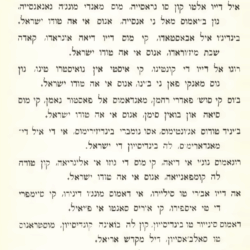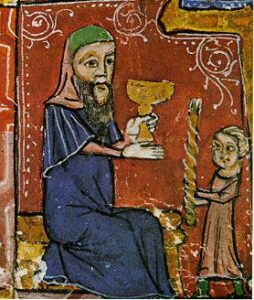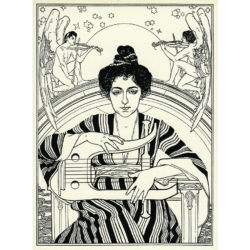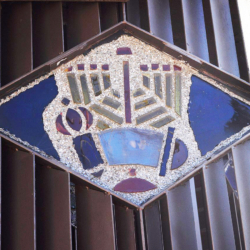Note: This translation also uses the plural pronouns They/Their/Them to refer to God as a pluralis majestatis, and to avoid the implications of God being assigned a gender. (Find Ibn Ezra’s commentary on Genesis 1:1 for a discussion of the pluralis majestatis when referring to God.) All divine referents (pronouns, epithets, names) are rendered in unicase.
| Source (Ladino) | Transliteration (Ladino, romanized) | Translation (English) |
|---|---|---|
איל דייו אלטו קון סו גראסייה מוס מאנדי מונגﬞה גאנאנסייה נון בﬞיאמוס מאל ני אנסייה אנוס אי אה טודו ישראל. |
El Dio alto kon su grasia mos mande muncha ganansia non veyamos mal ni ansia a nos i a todo Yisrael. |
May the lofty God, in Their grace send us much profit; let us see neither evil nor anxiety for us and for all Israel. |
בינדיגﬞו איל אבאסטאדו קי מוס דייו דיאה אונראדו קאדה שבת מיזﬞוראדו אנוס אי אה טודו ישראל. |
Bendicho el abastado ke mos dio dia onrado kada Shabat mejorado a nos i a todo Yisrael. |
Blessed be the Almighty who gave us an honored day every Shabbat made better for us and for all Israel. |
רוגו אל דייו די קונטינו קי איסטי אין נואיסטרו טינו נון נוס מאנקי פאן ני בﬞינו אנוס אי אה טודו ישראל. |
Rogo al Dio de kontino ke este en nuestro tino, non mos manke pan ni vino a nos i a todo Yisrael. |
I pray to the endless God that it be Their will for us not to lack bread or wine for us and for all Israel. |
בﬞוס קי סושﬞ פאדרי רחמן מאנדאמוס אל פאסטור נאמן קי מוס סיאה און בואין סימן אנוס אי אה טודו ישראל. |
Vos ke sosh Padre Rahman mandamos al pastor neeman ke mos sia un buen siman a nos i a todo Yisrael. |
You, who are the merciful Parent, send us the faithful shepherd, that he be for us a good sign for us and for all Israel. |
בﬞיניד טודוס אגﬞונטימוס אסו נומברי בינדיזירימוס אי די איל דימאנדארימוס לה בינדיסייון די ישראל. |
Venid todos adjuntemos a su nombre bendiziremos i de el demandaremos la bendisyon de Yisrael. |
C’mon, let’s all gather up to bless Their name, and of Them request the blessing of Israel. |
רוגאמוס נוגﬞי אי דיאה קי מוס די גוזו אי אליגריאה קון טודה לה קומפאנייאה אנוס אי אה טודו ישראל. |
Rogemos noche i dia Ke mos de gozo i alegria A toda la kompaniya a nos i a todo Yisrael. |
Let’s pray night and day that we are joyous and happy for all the community, for us and for all Israel. |
אה דייו אבﬞרי טו סיליירו אי דאמוס מונגﬞו דינירו קי סיימפרי די טי איספירו קי איריס סאנטו אי פﬞיאיל. |
Ah, Dio, avre tu sillero i damos muncho dinero ke siempre de ti espero ke eres santo i fiel. |
Ah, God, open Your granary and give us much money, for I always hope in You, for You are holy and true. |
דאמוס סינייור טו בינדיסייון קון לה בואינה קונדיסייון מוסטראנוס טו סאלבﬞאסייון דיל מקדשﬞ אריאל. |
Damos, Senyor, tu bendisyon kon la buena kondisyon mostranos tu salvasyon del Mikdash Ariel. |
Give us, Master, Your blessing with good condition; show us Your salvation of the temple of Ariel.[1] another name for Jerusalem; Find Isaiah 29:1. |
ייאה איס ביין אבאסטאדו לוקי אבﬞימוס פאסאדו מאנדאנוס אה איל אונטאדו משיח די ישראל. |
Ya es bien abastado lo ke avimos pasado mandamos a el untado mashiah de Yisrael. |
It’s more than enough, what we’ve already gone through! Send us the anointed messiah of Israel! |
מיכאל שר ישראל אליהו אי גבﬞריאל נוס בﬞינגה גﬞונטו קון איל גואל אה סאלאבﬞאר אה ישראל. |
Mihael sar Yisrael Eliyahu i Gavriel nos venga djunto kon el goel a salavar a Yisrael. |
Michael, prince of Israel, Elijah and Gabriel, come to us together with the redeemer to save Israel. |
There are many different versions of this beloved Ladino pizmon for Havdalah. This one is found in Tefilat Imanuel, published in Vienna in 1924.
Source(s)
Notes
| 1 | another name for Jerusalem; Find Isaiah 29:1. |
|---|

“איל דייו אלטו | El Dio Alto — a Ladino pizmon for Havdalah, Motsei Shabbat (transcribed and translated by Isaac Gantwerk Mayer)” is shared through the Open Siddur Project with a Creative Commons Attribution-ShareAlike 4.0 International copyleft license.











Leave a Reply